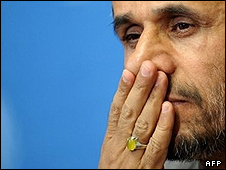What’s wrong with Iran’s economy?
Iranian President Mahmoud Ahmadinejad has run the executive branch of the country for seven and a half years and will be in the post for another six months. He has carried out large economic surgeries. Some believe that he has conducted surgeries without anesthetising the ailing economy by using force and threat, but some others say however, the economy was obliged to suffer the pain.
The implementation of the subsidy reform plan and the liberalisation of the currency market have been realised mostly during the current year.
After the Islamic Revolution's victory in 1979, the Iranian economy mostly experienced an inflation rate of above 10 per cent, but thanks to the injection of petrodollars into the economy, the devaluation of the rial against the dollar has not been at the same level with the inflation rate.
During the past year, the rial lost 100 per cent of its value against dollar. In other words, due to intensified sanctions and the fall in Forex incomes, maintaining the rial at a higher rate against dollar artificially is not possible anymore.
Also, cutting a portion of subsidies, especially in energy which amounted to $60 billion annually, was a must. Such subsidies had led to the smuggling of over 10 million litres of gasoline and diesel per day, considering the difference in their prices inside and outside the country.
Iran has a population of around 75 million. The alarm bell for the government is that the country consumes 63 million litres of gasoline per day, 153 billion cubic meters of natural gas per year and 94 billion cubic meters of water per year of which 91 per cent is consumed by the agriculture sector. Moreover, electricity consumption amounts to 185 billion kilowatt hours per year. These huge numbers are serious warning signals.
During his firm term of presidency, Ahmadinejad allocated some $20 billion to fast-yielding economic enterprises and self-employment plans in the form of loans, but not only did it prove to be unhelpful in reducing the jobless rate, but also it converted jobless people into debtors. This decision led to the accumulation of liquidity and outstanding debts to the banking sector, so that bad loans reached $57 billion, of which $38 billion is the government's share.
The administration pays $37 monthly as a cash subsidy to every Iranian, equalling $3 billion per month.
The economic surgeries of Ahmadinejad have seemingly not culminated in the planned results. Non-oil exports have not been increased considerably. The official unemployment rate is above 14 per cent. Even above 20 per cent according to some experts. Liquidity is above $300 billion and the inflation rate is above 25 per cent. The parliament speaker has also put the inflation rate at 29 per cent. These all are the unwelcome results of the administration's economic surgeries.
The Ahmadinejad administration is also blamed for allocating a major portion of $550 billion oil revenues (equal to 50 per cent of Iran's total 103-year oil income), which was gained during seven and a half years of his presidency, to the importation of staple foods and consumer goods.
The fall in oil output to 2.6 million barrels per day from four mbpd during the past seven years, the meagre rise in natural gas production and last but not the least, the delay in developing a number of the South Pars gas field phases, are among the signs of the administration's unsuccessful performance.
It is not known what the next government will devise to recover the situation which is referred to by some people as a crisis.


Comments
Post a Comment